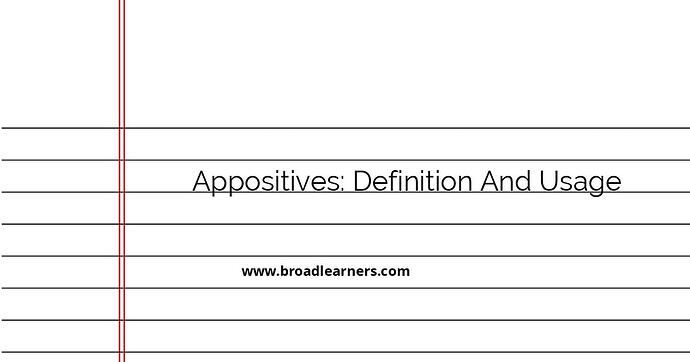Appositives are an essential part of English grammar that are used to give more information about a noun in a sentence. Whether you're looking to add descriptive details or clarify meaning, appositives can offer a seamless way to do so. In this article, we will delve deeply into the definition and usage of appositives, including examples for better comprehension.
Definition of Appositives
An appositive is a noun or noun phrase that follows another noun or pronoun to rename it or provide additional information about it. Appositives are typically set off by commas when they are non-restrictive, but when they are essential to the meaning of the sentence, commas are not used.
Characteristics of Appositives:
- An appositive can be a single word or a phrase.
- It typically follows the noun it is providing more information about.
- It can be restrictive (essential) or non-restrictive (non-essential).
- Example of an Appositive:
- Restrictive Appositive:
My friend Mike loves to play basketball. (In this sentence, 'Mike' is a restrictive appositive providing essential information about which friend is being referred to.)
- Non-Restrictive Appositive:
My brother, a talented musician, is performing tonight. (Here, 'a talented musician' adds more information about 'my brother' but is not essential for understanding who is performing.)
Usage of Appositives
Appositives can be used in various contexts to enhance clarity and detail in writing. They can provide additional information that enriches the reader's understanding. The placement and punctuation use with appositives need careful consideration.
Punctuation with Appositives:
- Use commas to set off non-restrictive appositives. The information is additional and not crucial for the identification of the noun.
- Do not use commas with restrictive appositives, as the appositive is integral to the noun's identification.
Examples with Different Sentences:
- Non-Restrictive:
My car, a red sedan, is parked outside. ('a red sedan' adds extra information about 'my car' and is set off by commas.)
- Restrictive:
Author J.K. Rowling wrote the Harry Potter series. (In this sentence, 'J.K. Rowling' specifies which author is being discussed, thus no commas are needed.)
Conclusion
Appositives play a crucial role in adding depth and clear context to who or what you are talking about in a sentence. By understanding and correctly using appositives, you can create richer, more informative text without compromising on clarity. Remember to consider whether the added information is essential when determining punctuation usage.
Did I miss anything? Respond below
